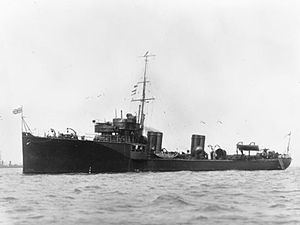Name HMS Exe Commissioned March 1904 Construction started 14 July 1902 Draft 2.24 m | Laid down 14 July 1902 Fate Sold, 10 February 1920 Launched 27 April 1905 | |
 | ||
Ordered 1901 – 1902 Naval Estimates Out of service Laid up in reserve awaiting disposal, 1919 | ||
HMS Exe was a River-class destroyer ordered by the Royal Navy under the 1901–1902 Naval Estimates. Named after the River Exe in southern England flowing through Exeter in the County of Devon, she was the first ship to carry this name in the Royal Navy. She served on the china Station before World War I and in the North Sea during the war. She was sold in 1920.
Contents
Construction
She was laid down on 14 July 1902 at the Palmer’s shipyard at Jarrow and launched on 27 April 1903. She was completed in March 1904. Her original armament was to be the same as the turtleback torpedo boat destroyers that preceded her. In 1906 the Admiralty decided to upgrade the armament by landing the five QF 6-pounder (8 cwt) guns and shipping three QF 12-pounder 8 cwt guns. Two would be mounted abeam at the forecastle break and the third gun would be mounted on the quarterdeck.
Pre-war
After commissioning she was assigned to China Station in late 1904. In September 1905 Exe under the command of Commander Alan Everett, while accompanying HMS Dee encountered a severe typhoon between Wei-hai-wei and Shanghai. Both ships weathered the storm and proved the seaworthiness of the River class design.
On 30 August 1912 the Admiralty directed all destroyer classes were to be designated by alpha characters starting with the letter 'A'. The ships of the River class were assigned to the E class. After 30 September 1913, she was known as an E-class destroyer and had the letter ‘E’ painted on the hull below the bridge area and on either the fore or aft funnel.
World War I
Upon her return to Home Waters 1914 she was in the 9th Destroyer Flotilla based at Chatham tendered to HMS St George. The 9th Flotilla was a patrol flotilla tasked with anti-submarine and counter mining patrols in the Firth of Forth area. Soon after the commencement of hostilities she was deployed to the Scapa Flow Local Flotilla under the command of the Commander-in-Chief Home Fleet tendered to HMS King George V. Her duties here included counter-mining patrols and antisubmarine measures in defence of the Fleet anchorage.
In August 1915 with the amalgamation of the 9th and 7th Flotillas she was deployed to the 7th Destroyer Flotilla based at the River Humber. She remained employed on the Humber Patrol participating in counter-mining operations and anti-submarine patrols for the remainder of the war.
Fate
In 1919 she was paid off and laid up in reserve awaiting disposal. On 10 February 1920 she was sold to Thos W Ward of Sheffield for breaking at Rainham, Kent, on the Thames Estuary.
